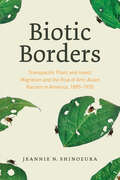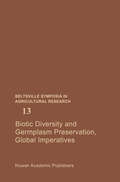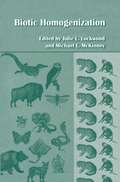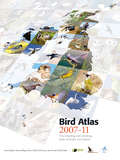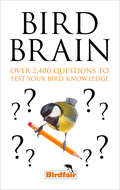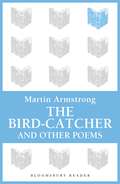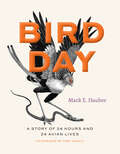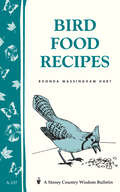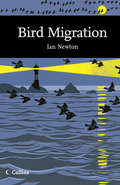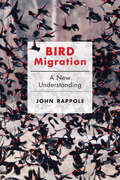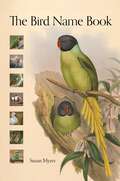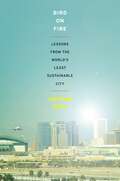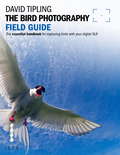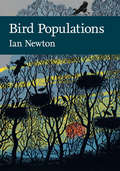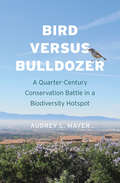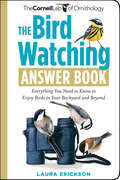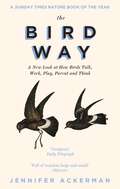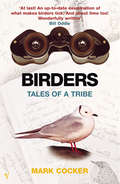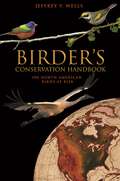- Table View
- List View
Biotic Borders: Transpacific Plant and Insect Migration and the Rise of Anti-Asian Racism in America, 1890–1950
by Jeannie N. ShinozukaA rich and eye-opening history of the mutual constitution of race and species in modern America. In the late nineteenth century, increasing traffic of transpacific plants, insects, and peoples raised fears of a "biological yellow peril" when nursery stock and other agricultural products shipped from Japan to meet the growing demand for exotics in the United States. Over the next fifty years, these crossings transformed conceptions of race and migration, played a central role in the establishment of the US empire and its government agencies, and shaped the fields of horticulture, invasion biology, entomology, and plant pathology. In Biotic Borders, Jeannie N. Shinozuka uncovers the emergence of biological nativism that fueled American imperialism and spurred anti-Asian racism that remains with us today. Shinozuka provides an eye-opening look at biotic exchanges that not only altered the lives of Japanese in America but transformed American society more broadly. She shows how the modern fixation on panic about foreign species created a linguistic and conceptual arsenal for anti-immigration movements that flourished in the early twentieth century. Xenophobia inspired concerns about biodiversity, prompting new categories of “native” and “invasive” species that defined groups as bio-invasions to be regulated—or annihilated. By highlighting these connections, Shinozuka shows us that this story cannot be told about humans alone—the plants and animals that crossed with them were central to Japanese American and Asian American history. The rise of economic entomology and plant pathology in concert with public health and anti-immigration movements demonstrate these entangled histories of xenophobia, racism, and species invasions.
Biotic Borders: Transpacific Plant and Insect Migration and the Rise of Anti-Asian Racism in America, 1890–1950
by Jeannie N. ShinozukaA rich and eye-opening history of the mutual constitution of race and species in modern America. In the late nineteenth century, increasing traffic of transpacific plants, insects, and peoples raised fears of a "biological yellow peril" when nursery stock and other agricultural products shipped from Japan to meet the growing demand for exotics in the United States. Over the next fifty years, these crossings transformed conceptions of race and migration, played a central role in the establishment of the US empire and its government agencies, and shaped the fields of horticulture, invasion biology, entomology, and plant pathology. In Biotic Borders, Jeannie N. Shinozuka uncovers the emergence of biological nativism that fueled American imperialism and spurred anti-Asian racism that remains with us today. Shinozuka provides an eye-opening look at biotic exchanges that not only altered the lives of Japanese in America but transformed American society more broadly. She shows how the modern fixation on panic about foreign species created a linguistic and conceptual arsenal for anti-immigration movements that flourished in the early twentieth century. Xenophobia inspired concerns about biodiversity, prompting new categories of “native” and “invasive” species that defined groups as bio-invasions to be regulated—or annihilated. By highlighting these connections, Shinozuka shows us that this story cannot be told about humans alone—the plants and animals that crossed with them were central to Japanese American and Asian American history. The rise of economic entomology and plant pathology in concert with public health and anti-immigration movements demonstrate these entangled histories of xenophobia, racism, and species invasions.
Biotic Diversity and Germplasm Preservation, Global Imperatives (Beltsville Symposia in Agricultural Research #13)
by Lloyd Knutson Allan K. StonerTopics for the Beltsville Symposia are selected to highlight specific areas of research and science policy that are of concern to scientists in the Beltsville Area as well as to the general scientific community. Each sympo sium in the series is structured to provide a realistic appraisal of current findings, research progress, and relevant policy issues within the constraints established by the organizing committee. Thus, the presentations and dis cussions that have marked these symposia have had a strong appeal to the broad community of scientists. Knowledge of the diversity of living organisms is still quite limited. Since the time of Linnaeus, about 1.7 million species have been described. The actual number has been estimated between 5-50 million. Many species, land races, and strains are vanishing. Clearly, the world's scientific institutions are inadequately equipped to attain sufficient knowledge of a significant fraction of the diverse living forms. Also, efforts in the collection and preservation of germplasm of plants and animals urgently need to be strengthened. These mattes are critically important to future generations. This symposium addresses vital concerns of biotic diversity and germ plasm preservation from diverse perspectives. Many of the parts provide concrete recommendations for action, and they call attention to areas of research that must be pursued with intensity.
Biotic Homogenization
by Michael L. McKinney Julie L. LockwoodBiological homogenization is the dominant process shaping the future global biosphere. As global transportation becomes faster and more frequent, it is inevitable that biotic intermixing will increase. Unique local biotas will become extinct only to be replaced by already widespread biotas that can tolerate human activities. This process is affecting all aspects of our world: language, economies, and ecosystems alike. The ultimate outcome is the loss of uniqueness and the growth of uniformity. In this way, fast food restaurants exist in Moscow and Java Sparrows breed on Hawaii. Biological homogenization qualifies as a global environmental catastrophe. The Earth has never witnessed such a broad and complete reorganization of species distributions.
Bird Atlas 2007-11: The Breeding And Wintering Birds Of Britain And Ireland
by Dawn Balmer Simon Gillings Brian Caffrey Bob Swann Iain Downie Rob FullerRecommended for viewing on a colour tablet. The Bird Atlas 2007–2011 is the definitive statement on breeding and winter bird distributions in Britain and Ireland.
Bird Brain: Over 2,400 Questions To Test Your Bird Knowledge
by William CollinsAn ornithological quiz book packed with challenging questions for birders, based on the popular ‘Bird Brain of Britain’ contest at the annual BirdFair.
The Bird-Catcher
by Martin ArmstrongThis beautiful collection of poems tells tales of blossoming springs and fruitful summers; in Honey Harvest Armstrong depicts Spring with the overweight apple blossom nodding on their branches and the sweet honey filling our shelves, and in Spanish Vintage we are almost able to taste the plump purple grapes of August as we follow their journey through the seasons, maturing in the dark bodegas ready to be sipped when the time is just right.This nature-inspired collection of poems was first published in 1929.
Bird Day: A Story of 24 Hours and 24 Avian Lives (Earth Day)
by Mark E. HauberAn hourly guide that follows twenty-four birds as they find food, mates, and safety from predators. From morning to night and from the Antarctic to the equator, birds have busy days. In this short book, ornithologist Mark E. Hauber shows readers exactly how birds spend their time. Each chapter covers a single bird during a single hour, highlighting twenty-four different bird species from around the globe, from the tropics through the temperate zones to the polar regions. We encounter owls and nightjars hunting at night and kiwis and petrels finding their way in the dark. As the sun rises, we witness the beautiful songs of the “dawn chorus.” At eleven o’clock in the morning, we float alongside a common pochard, a duck resting with one eye open to avoid predators. At eight that evening, we spot a hawk swallowing bats whole, gorging on up to fifteen in rapid succession before retreating into the darkness. For each chapter, award-winning artist Tony Angell has depicted these scenes with his signature pen and ink illustrations, which grow increasingly light and then dark as our bird day passes. Working closely together to narrate and illustrate these unique moments in time, Hauber and Angell have created an engaging read that is a perfect way to spend an hour or two—and a true gift for readers, amateur scientists, and birdwatchers.
Bird Day: A Story of 24 Hours and 24 Avian Lives (Earth Day)
by Mark E. HauberAn hourly guide that follows twenty-four birds as they find food, mates, and safety from predators. From morning to night and from the Antarctic to the equator, birds have busy days. In this short book, ornithologist Mark E. Hauber shows readers exactly how birds spend their time. Each chapter covers a single bird during a single hour, highlighting twenty-four different bird species from around the globe, from the tropics through the temperate zones to the polar regions. We encounter owls and nightjars hunting at night and kiwis and petrels finding their way in the dark. As the sun rises, we witness the beautiful songs of the “dawn chorus.” At eleven o’clock in the morning, we float alongside a common pochard, a duck resting with one eye open to avoid predators. At eight that evening, we spot a hawk swallowing bats whole, gorging on up to fifteen in rapid succession before retreating into the darkness. For each chapter, award-winning artist Tony Angell has depicted these scenes with his signature pen and ink illustrations, which grow increasingly light and then dark as our bird day passes. Working closely together to narrate and illustrate these unique moments in time, Hauber and Angell have created an engaging read that is a perfect way to spend an hour or two—and a true gift for readers, amateur scientists, and birdwatchers.
Bird Food Recipes: Storey Country Wisdom Bulletin A-137 (Storey Country Wisdom Bulletin)
by Rhonda Massingham HartSince 1973, Storey's Country Wisdom Bulletins have offered practical, hands-on instructions designed to help readers master dozens of country living skills quickly and easily. There are now more than 170 titles in this series, and their remarkable popularity reflects the common desire of country and city dwellers alike to cultivate personal independence in everyday life.
Bird Migration (Collins New Naturalist Library #113)
by Ian NewtonThe phenomenon of bird migration has fascinated people from time immemorial. The arrivals and departures of different species marked the seasons, heralding spring and autumn, and providing a reliable calendar long before anything better became available.
Bird Migration: A New Understanding
by John H. RappoleA fascinating and nuanced exploration of why, how, and which birds migrate.Bird migration captivates the human imagination, yet for most of us, key aspects of the phenomenon remain a mystery. How do birds sense the ideal moment to take wing, and once the epic journey has begun, how do they find their distant destinations? Fresh insights about avian movements are still constantly emerging, powered by new tools like molecular genetics and transmitter miniaturization. In this book, renowned ornithologist and author John H. Rappole reveals intriguing results of recent scientific studies on migration, explaining their importance for birders, nature lovers, and researchers alike. Debunking misconceptions about the lives of birds that have persisted for thousands of years, Rappole explores unexpected causes and previously misunderstood aspects of the annual migration cycle. From the role of migrating birds in zoonotic disease transmission to climate change's impact on migration patterns, Rappole tackles crucial questions and ensures that readers come away with a new understanding of why and how birds migrate.
Bird Migration: A New Understanding
by John H. RappoleA fascinating and nuanced exploration of why, how, and which birds migrate.Bird migration captivates the human imagination, yet for most of us, key aspects of the phenomenon remain a mystery. How do birds sense the ideal moment to take wing, and once the epic journey has begun, how do they find their distant destinations? Fresh insights about avian movements are still constantly emerging, powered by new tools like molecular genetics and transmitter miniaturization. In this book, renowned ornithologist and author John H. Rappole reveals intriguing results of recent scientific studies on migration, explaining their importance for birders, nature lovers, and researchers alike. Debunking misconceptions about the lives of birds that have persisted for thousands of years, Rappole explores unexpected causes and previously misunderstood aspects of the annual migration cycle. From the role of migrating birds in zoonotic disease transmission to climate change's impact on migration patterns, Rappole tackles crucial questions and ensures that readers come away with a new understanding of why and how birds migrate.
The Bird Name Book: A History of English Bird Names
by Susan MyersA marvelously illustrated A-to-Z compendium of bird names from around the globeThe Bird Name Book is an alphabetical reference book on the origins and meanings of common group bird names, from “accentor” to “zeledonia.” A cornucopia of engaging facts and anecdotes, this superbly researched compendium presents a wealth of incisive entries alongside stunning photos by the author and beautiful historic prints and watercolors. Myers provides brief biographies of prominent figures in ornithology—such as John Gould, John Latham, Alfred Newton, and Robert Ridgway—and goes on to describe the etymological history of every common group bird name found in standardized English. She interweaves the stories behind the names with quotes from publications dating back to the 1400s, illuminating the shared evolution of language and our relationships with birds, and rooting the names in the history of ornithological discovery.Whether you are a well-traveled birder or have ever wondered how the birds in your backyard got their names, The Bird Name Book is an ideal companion.
The Bird Name Book: A History of English Bird Names
by Susan MyersA marvelously illustrated A-to-Z compendium of bird names from around the globeThe Bird Name Book is an alphabetical reference book on the origins and meanings of common group bird names, from “accentor” to “zeledonia.” A cornucopia of engaging facts and anecdotes, this superbly researched compendium presents a wealth of incisive entries alongside stunning photos by the author and beautiful historic prints and watercolors. Myers provides brief biographies of prominent figures in ornithology—such as John Gould, John Latham, Alfred Newton, and Robert Ridgway—and goes on to describe the etymological history of every common group bird name found in standardized English. She interweaves the stories behind the names with quotes from publications dating back to the 1400s, illuminating the shared evolution of language and our relationships with birds, and rooting the names in the history of ornithological discovery.Whether you are a well-traveled birder or have ever wondered how the birds in your backyard got their names, The Bird Name Book is an ideal companion.
Bird on Fire: Lessons from the World's Least Sustainable City
by Andrew RossPhoenix, Arizona is one of America's fastest growing metropolitan regions. It is also its least sustainable one, sprawling over a thousand square miles, with a population of four and a half million, minimal rainfall, scorching heat, and an insatiable appetite for unrestrained growth and unrestricted property rights. In Bird on Fire, eminent social and cultural analyst Andrew Ross focuses on the prospects for sustainability in Phoenix--a city in the bull's eye of global warming--and also the obstacles that stand in the way. Most authors writing on sustainable cities look at places that have excellent public transit systems and relatively high density, such as Portland, Seattle, or New York. But Ross contends that if we can't change the game in fast-growing, low-density cities like Phoenix, the whole movement has a major problem. Drawing on interviews with 200 influential residents--from state legislators, urban planners, developers, and green business advocates to civil rights champions, energy lobbyists, solar entrepreneurs, and community activists--Ross argues that if Phoenix is ever to become sustainable, it will occur more through political and social change than through technological fixes. Ross explains how Arizona's increasingly xenophobic immigration laws, science-denying legislature, and growth-at-all-costs business ethic have perpetuated social injustice and environmental degradation. But he also highlights the positive changes happening in Phoenix, in particular the Gila River Indian Community's successful struggle to win back its water rights, potentially shifting resources away from new housing developments to producing healthy local food for the people of the Phoenix Basin. Ross argues that this victory may serve as a new model for how green democracy can work, redressing the claims of those who have been aggrieved in a way that creates long-term benefits for all. Bird on Fire offers a compelling take on one of the pressing issues of our time--finding pathways to sustainability at a time when governments are dismally failing in their responsibility to address climate change.
Bird on Fire: Lessons from the World's Least Sustainable City
by Andrew RossPhoenix, Arizona is one of America's fastest growing metropolitan regions. It is also its least sustainable one, sprawling over a thousand square miles, with a population of four and a half million, minimal rainfall, scorching heat, and an insatiable appetite for unrestrained growth and unrestricted property rights. In Bird on Fire, eminent social and cultural analyst Andrew Ross focuses on the prospects for sustainability in Phoenix--a city in the bull's eye of global warming--and also the obstacles that stand in the way. Most authors writing on sustainable cities look at places that have excellent public transit systems and relatively high density, such as Portland, Seattle, or New York. But Ross contends that if we can't change the game in fast-growing, low-density cities like Phoenix, the whole movement has a major problem. Drawing on interviews with 200 influential residents--from state legislators, urban planners, developers, and green business advocates to civil rights champions, energy lobbyists, solar entrepreneurs, and community activists--Ross argues that if Phoenix is ever to become sustainable, it will occur more through political and social change than through technological fixes. Ross explains how Arizona's increasingly xenophobic immigration laws, science-denying legislature, and growth-at-all-costs business ethic have perpetuated social injustice and environmental degradation. But he also highlights the positive changes happening in Phoenix, in particular the Gila River Indian Community's successful struggle to win back its water rights, potentially shifting resources away from new housing developments to producing healthy local food for the people of the Phoenix Basin. Ross argues that this victory may serve as a new model for how green democracy can work, redressing the claims of those who have been aggrieved in a way that creates long-term benefits for all. Bird on Fire offers a compelling take on one of the pressing issues of our time--finding pathways to sustainability at a time when governments are dismally failing in their responsibility to address climate change.
The Bird Photography Field Guide: The Essential Handbook for Capturing Birds with your digital SLR (Field Guide)
by David TiplingA specialist title aimed at bird watchers, this handy book contains all the expertise you need to make your bird-watching trip into a rewarding photo session: there is copious advice on equipment, technique and field craft, and a wealth of wonderful photos to inspire you. Finally, a section on the digital darkroom will help you turn your shots into perfect prints.
Bird Populations (Collins New Naturalist Library #124)
by Ian NewtonIn the latest addition to the New Naturalist series, Ian Newton explores bird populations and what causes their fluctuation – food supplies, competitors, predators, parasites, pathogens and human activity.
Bird versus Bulldozer: A Quarter-Century Conservation Battle in a Biodiversity Hotspot
by Audrey MayerAn examination of the struggle to conserve biodiversity in urban regions, told through the story of the threatened coastal California gnatcatcher The story of the rare coastal California gnatcatcher is a parable for understanding the larger ongoing struggle to conserve biodiversity in regions confronted with intensifying urban development. Because this gnatcatcher depends on vanishing coastal sage scrub in Southern California, it has been regarded as a flagship species for biodiversity protection since the early 1990s. But the uncertainty of the gnatcatcher’s taxonomic classification—and whether it can be counted as a “listable unit” under the Endangered Species Act—has provoked contentious debate among activists, scientists, urban developers, and policy makers. Synthesizing insights from ecology, environmental history, public policy analysis, and urban planning as she tracks these debates over the course of the past twenty-five years, Audrey L. Mayer presents an ultimately optimistic take on the importance of much-neglected regional conservation planning strategies to create sustainable urban landscapes that benefit humans and wildlife alike.
The Bird Watching Answer Book: Everything You Need to Know to Enjoy Birds in Your Backyard and Beyond
by Laura EricksonLearn the how&’s and why&’s of bird behavior, from flirtatious mating practices and gorgeous birdsong to flying south for the winter. In this lively reference book, Laura Erickson addresses hundreds of real-life questions sent in to the Cornell Lab of Ornithology, the world&’s foremost authority on birds. With expert advice on bird watching techniques and equipment, feeding and housing birds, protecting habitats, and much more, Erickson guides you through the intricacies of the avian world with a contagious passion for our feathered friends.
The Bird Way: A New Look at How Birds Talk, Work, Play, Parent, and Think
by Jennifer AckermanFrom the New York Times bestselling author of The Genius of Birds, a radical investigation into the bird way of being, and the recent scientific research that is dramatically shifting our understanding of birds. 'There is the mammal way and there is the bird way.' This is one scientist's pithy distinction between mammal brains and bird brains: two ways to make a highly intelligent mind. But lately, scientists have taken a new look at bird behaviours they've previously dismissed as anomalies. What they're finding is upending the traditional view of how birds live, how they communicate, forage, court, survive. They're also revealing the remarkable intelligence underlying these activities, abilities we once considered uniquely our own - deception, manipulation, kidnapping, infanticide, but also, ingenious communication between species, collaboration, altruism and play. Some of these behaviours are biological conundrums that seem to push the edges of - well - birdness: A mother bird that kills her own infant sons, and another that selflessly tends to the young of other birds. Young birds that devote themselves to feeding their siblings and others so competitive they'll stab their nestmates to death. Birds that give gifts and birds that steal, birds that dance or drum, that paint their creations or paint themselves, and birds that summon playmates with a special call - and may hold the secret to our own penchant for playfulness and the evolution of laughter. Drawing on personal observations, the latest science, and her bird-related travel around the world, Ackerman shows there is clearly no single bird way of being. In every respect, in plumage, form, song, flight, lifestyle, niche, and behaviour, birds vary. It's what we love about them.
Birders: Tales Of A Tribe
by Mark CockerSince 1972 Mark Cocker has been a member of a community of obsessional people, almost all male, who sacrifice most of their spare time, a good deal of money, sometimes their chances of a partner or family, even occasionally their lives, to watch birds. Birders is the story of this community, of its characters, its rules, its equipment and its adventures - many of which are hilariously funny, Birders is also a work of love - the story of what birds can do to the human heart.
Birder's Conservation Handbook: 100 North American Birds at Risk
by Jeffrey V. WellsUntil now there has been no single, comprehensive resource on the status of North America's most threatened birds and what people can do to help protect them. Birder's Conservation Handbook is the only book of its kind, written specifically to help birders and researchers understand the threats while providing actions to protect birds and their habitats. Jeffrey Wells has distilled vast amounts of essential information into a single easy-to-use volume-required reading for anyone who loves birds and wants to ensure they are protected. At-a-glance species accounts cover in detail North America's one hundred most at-risk birds; each account is beautifully illustrated by today's top bird artists. The text includes status, distribution, ecology, threats, conservation actions and needs, and references. A distribution map accompanies each entry. Chapters discuss birds as indicators of environmental health, the state of North American bird populations, major conservation issues, and initiatives now underway to improve the health of North America's birds. Birder's Conservation Handbook is an indispensable resource for birdwatchers, researchers, naturalists, and conservationists. Reading it will inspire you to become an active steward of our birds and the habitats we share. A comprehensive guide to North America's one hundred most at-risk birds and how to protect them Compact and easy to use, with beautiful illustrations and data organized for convenient, at-a-glance reference Detailed species accounts, including distribution maps Practical advice on conservation Information on leading conservation agencies and resources
Birder's Conservation Handbook (PDF): 100 North American Birds at Risk
by Jeffrey V. WellsUntil now there has been no single, comprehensive resource on the status of North America's most threatened birds and what people can do to help protect them. Birder's Conservation Handbook is the only book of its kind, written specifically to help birders and researchers understand the threats while providing actions to protect birds and their habitats. Jeffrey Wells has distilled vast amounts of essential information into a single easy-to-use volume-required reading for anyone who loves birds and wants to ensure they are protected. At-a-glance species accounts cover in detail North America's one hundred most at-risk birds; each account is beautifully illustrated by today's top bird artists. The text includes status, distribution, ecology, threats, conservation actions and needs, and references. A distribution map accompanies each entry. Chapters discuss birds as indicators of environmental health, the state of North American bird populations, major conservation issues, and initiatives now underway to improve the health of North America's birds. Birder's Conservation Handbook is an indispensable resource for birdwatchers, researchers, naturalists, and conservationists. Reading it will inspire you to become an active steward of our birds and the habitats we share. A comprehensive guide to North America's one hundred most at-risk birds and how to protect them Compact and easy to use, with beautiful illustrations and data organized for convenient, at-a-glance reference Detailed species accounts, including distribution maps Practical advice on conservation Information on leading conservation agencies and resources
